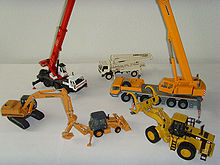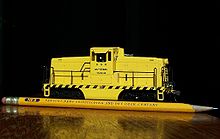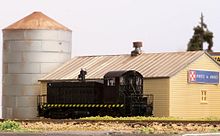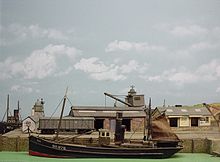- Scale model
-
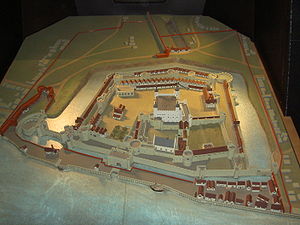 A scale model of the Tower of London. This model can be found inside the tower.
A scale model of the Tower of London. This model can be found inside the tower.
 L to R with 12 inch ruler at bottom: 1:64 Matchbox Chevrolet Tahoe, 1:43 Ford F-100, 1:25 Revell Monogram 1999 Ford Mustang Cobra, 1:18 Bburago 1987 Ferrari F40
L to R with 12 inch ruler at bottom: 1:64 Matchbox Chevrolet Tahoe, 1:43 Ford F-100, 1:25 Revell Monogram 1999 Ford Mustang Cobra, 1:18 Bburago 1987 Ferrari F40
A scale model is a physical model, a representation or copy of an object that is larger or smaller than the actual size of the object, which seeks to maintain the relative proportions (the scale factor) of the physical size of the original object. Very often the scale model is used as a guide to making the object in full size. Scale models are built or collected for many reasons.
Professional modelmakers often create models for many professions:
- Engineers who require scale models to test the likely performance of a particular design at an early stage of development without incurring the full expense of a full-sized prototype.
- Architects who require architectural models to evaluate and sell the look of a new construction before it is built.
- Filmmakers who require scale models of objects or sets that cannot be built in full size.
- Salesmen who require scale models to promote new products such as heavy equipment and automobiles and other vehicles.
Hobbyists or amateur modelmakers make die-cast models, injection molded, model railroads, remote control vehicles, wargaming and fantasy collectibles, model ships and ships in bottles for their own enjoyment.
Scale models can also be objects of art, either being created by artists or being rediscovered and transformed into art by artists.
Types of scale models
Some modelers build and collect models made from a certain medium ( Metal, wood, plastic, card, paper, etc.). Others build and collect models based on the types of object being modeled.
Model aircraft
Main article: Model aircraftScale model of a Douglas DC-3
Model aircraft are divided into two main groups: static and flying models.
Static model aircraft
Static model aircraft are commonly built using plastic, but wood, metal, card and paper can also be used. Models are sold painted and assembled, painted but not assembled (snap-fit) or unpainted and not assembled. The most popular types of aircraft to model are commercial airliners and military aircraft. Fewer manufacturers exist today than in the 1970s, but many of the older kits are occasionally available to purchase. Aircraft can be modeled in many "scales". The scale notation is the size of the model compared to the real, full-size aircraft called the "prototype". We'll use 1:8 scale as an example, it is read like this: "1 inch (or whatever measurement) on my model is equal (: means equal) to 8 inches on the real (prototype) airplane". Sometimes the scale notation isn't used...it's simply stated; "my model is one eighth (1/8) scale" meaning; "my model is one eighth the size of the real airplane" or "my model is eight times smaller than the real airplane". Popular scales are, in order of size, 1:144, 1:72 (the most numerous), 1:48, 1:32, 1:24, 1:16, 1:8 and 1:4. Some European models are available at more metric scales such as 1:50. The highest quality models are made from injection-molded plastic or cast resin. Models made from Vacuum formed plastic are generally for the more skilled builder. More inexpensive models are made from heavy paper or card stock. Ready-made die-cast metal models are also very popular. As well as the traditional scales, die-cast models are available in 1:200, 1:250, 1:350, 1:400, and 1:600. These scales are usually reserved for civil airliners. Static aircraft scale modeling falls broadly into 3 categories: kit assembly, scratch-building, and collection of ready-made models. Scratch-builders tend to be the top echelon in terms of skill and craftsmanship; they tend to be the most discerning when it comes to accuracy and detail and they spend far more time on far fewer models than a kit assembler. Kit assemblers fall roughly into 2 categories: OOB (Out of Box) and Modified. Out of Box refers to the act of assembling a kit only from what is contained in the box supplied, whereas a Modifier will employ after-market products such as alternative decals, photo-etched metal detail parts, and cast resin detail or conversion parts to enhance or change the model in some way. Collectors are concerned purely with the issue of theme, and are not really interested in personal construction as such. Obviously aircraft modelers will often fall into more than one category as fancy takes them. The overwhelming majority of aircraft modelers concern themselves with depiction of real-life aircraft, but there is a smaller cadre of modelers who derive additional fun by 'bending' history a little by making models of aircraft that either never actually flew or existed, or by painting them in a color scheme that did not actually exist. This is commonly referred to as 'What-if' or 'Alternative' modeling, and the most common theme is 'Luftwaffe 1946' or 'Luftwaffe '46'. This theme stems from idea of modeling German secret projects that never saw the light of day due to the close of World War II. This concept has been extended to include British, Russian, and US experimental projects that never made it into production.
Flying model aircraft
Main article: Radio-controlled aircraftFlying models are usually what is meant by the term aeromodelling. Most flying model aircraft can be placed in one of three groups: free flight, control line and radio controlled. Some flying models are realistic representation of full-sized aircraft, while others are built with no intention of looking like piloted aircraft. Flying models are often constructed like vintage full-sized aircraft. They can be built from scratch or from kits. Some kits take many hours to put together and some kits are almost ready to fly or ready to fly.
Plans-relief
Main article: Plan-reliefWith elements similar to miniature wargaming, building models and architectural models, a plan-relief is a means of geographical representation in relief as a scale model for military use, in order to visualise building projects on fortifications or campaigns involving fortifications.
Model buildings
Main article: Building modelModel building for an H0 scale railroad
Most hobbyist who build models of buildings do so as part of a diorama to enhance their other models such as a model railroad or model war machines. As a stand-alone hobby, building models are probably most popular among enthusiasts of construction toys such as Erector, Lego and K'nex. Famous landmarks such as the Empire State Building, Big Ben and the White House are common subjects. Standard scales have not emerged in this hobby. Model railroaders use railroad scales for their buildings: H0 scale (1:87), OO scale (1:76), N scale (1:160), and O scale (1:43). Lego builders use miniland scale (1:20) and minifig scale (1:48) and micro scale (1:192)[1] Generally, the larger the building, the smaller the scale. Model buildings are commonly made from plastic, foam, balsa wood or paper. Card models are published in the form of a book, and some models are manufactured like 3-D puzzles. Professionally, building models are used by architects and salesmen.
Architectural models
Main article: Architectural modelArchitecture firms usually employ model makers or contract model making firms to make models of projects to sell their designs to builders and investors. These models are traditionally hand-made, but advances in technology have turned the industry into a very high tech process than can involve Class IV laser cutters, 5-axis CNC machines as well as rapid prototyping or 3D printing. Typical scales are 1:12, 1:24, 1:48, 1:50, 1:100, 1:200, 1:500, etc.
Dollhouses
Main article: DollhouseContemporary dollhouses have their roots in European baby house display cases from the 17th century. Early dollhouses were all handmade, but following the Industrial Revolution and World War II, they were increasingly mass produced and became more affordable.
Children's dollhouses during the 20th century have been made from a variety of materials, including metal (tin litho), fibreboard, plastic, and wood. Furniture for children's dollhouses has most often been made of plastic. Contemporary kit and fully built houses for adult collectors are typically made of plywood or medium-density fiberboard.
Children's dollhouses are commonly in 1:16 or 1:18 scale (3/4" and 2/3" scale respectively, 1 foot is represented by 3/4 or 2/3 of an inch), while dollhouses for adult collectors are usually in a scale of 1:12 (1 inch equals 1 foot).
House portrait models
Main article: Model houseTypically found in 1:50 scale and also called Model House, Model Home or Display House. This type of model is usually found in stately homes or specially designed houses. Sometimes this kind of model is commissioned to mark a special date like an anniversary or the completion of the architecture, or these models might be used by salesmen selling homes in a new neighborhood.
Model buses and trucks
Main article: Model commercial vehicleTypically found in 1:50 scale, most manufacturers of commercial vehicles and heavy equipment will commission scale models made of diecast metal as promotional items to be given to prospective customers. These are also popular children's toys and collectibles. The major manufacturers of these items are Conrad and NZG in Germany. Corgi also makes some 1:50 models, as well as Dutch maker Tekno.
Trucks are also found as diecast models in 1:43 scale and injection moulded kits (and children's toys) in 1:24 scale. Recently some manufacturers have appeared in 1:64 scale like Code 3.
Model cars
Main article: Model carAlthough the British scale for 0 gauge was first used for model cars made of rectilinear and circular parts, it was the origin of the European scale for cast or injection moulded model cars. MOROP's specification of 1:45 scale for European 0 will not alter the series of cars in 1:43 scale, as it has the widest distribution in the world.
In America, a series of cars was developed from at first cast metal and later styrene models ("promos") offered at new-car dealerships to drum up interest. The firm Monogram, and later Tamiya, first produced them in a scale derived from the Architect's scale: 1:24 scale, while the firms AMT, Jo-Han, and Revell chose the scale of 1:25. Monogram later switched to this scale after the firm was purchased by Revell. Some cars are also made in 1:32 scale, and rolling toys are often made on the scale 1:64 scale. Chinese die-cast manufacturers have recently introduced 1/72 scale into their range.The smaller scales are usually die-cast cars and not the in the class as model cars. Except in rare occasions, Johnny Lightning and Ertl made die-cast cars where sold, as model kits to be put together
Model cars are also used in car design.
Handbuilt model cars are a unique market, usually in 1/43rd scale and created by Manufacturers such as Marsh Models, SMTS, Somerville, K&R Replicas etc., these patterns for the relevant subjects are made by skilled Pattern makers in various materials and various scales, see bottom of page for link
Model construction vehicles
A model construction vehicle (or engineering vehicle) is a scale model or Die-cast toy that represents a construction vehicle such as an excavator, crane, concrete pump, backhoe, etc.
Construction vehicle models are almost always made in 1:50 scale, particularly because the cranes at this scale are often three to four feet tall when extended and larger scales would be unsuited for display on a desk or table. These models are popular as children's toys in Germany. In the US they are commonly sold as promotional models for new construction equipment, commissioned by the manufacturer of the prototype real-world equipment. The major manufacturers in Germany are Conrad and NZG, with some competition from Chinese firms that have been entering the market.
Model railways
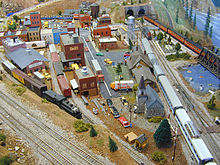 An H0 scale model railroad.
An H0 scale model railroad. An N scale locomotive.
An N scale locomotive. Main article: Rail transport modelling
Main article: Rail transport modellingModel trains come in a variety of scales, from 1:8 on the large end and 1:450 (T scale) on the small. Each scale has its own strengths and weaknesses, and fills a different niche in the hobby. The largest models are as much as 3 meters long, the smallest a few centimeters. The most popular size is H0 scale (1:87) and second is N scale (1:160).
Model railways originally used the term "gauge", which refers to the distance between the rails, just as full-size railways do. Although model railways were also built to different gauges, "standard gauge" in 1:1 scale railroads is 4'8.5." Therefore, a model railway reduces that standard to scale. An H0 scale model railway would have track that is 1/87 of 4'8.5," or about 0.65" from rail to rail. Now it is more typical to refer to the scale of the model, and the term scale has replaced "gauge" in most usages. This is despite considerable confusion between countries as to the definition of 0 scale and N scale.
Considerable confusion often arises when referring to "scale" and "gauge", especially as some misinformed individuals tend to use the words interchangeably. The word "scale" only ever refers to the proportional size of the model, the word "gauge" only ever applies to the measurement between the inside faces of the rails. To highlight this difference, consider the various gauges used in H0 scale; A gauge of 16.5 mm is used to represent the "Standard gauge" of 4 ft 8 1⁄2 in (1,435 mm) (H0 scale), a gauge of 12 mm is used to represent 1,000 mm (3 ft 3 3⁄8 in) gauge (H0m) and the "Cape gauge" of 3 ft 6 in (1,067 mm) (H0n3-1/2) and a gauge of 9 mm is used to represent a prototype gauge of 2 ft (610 mm). It is completely incorrect to refer to the mainstream scales as "H0 gauge", "N gauge" or "Z gauge"
The most popular scale to go with a given gauge was often derived at by the following roundabout process. German artisans would take strips of metal of standard metric size to make things to blueprints whose dimensions were in inches: hence "4 mm to the foot" yields the 1:76.2 size of the "00 scale". This British scale is anomalously used on the standard H0/00 scale (16.5 mm gauge from 3.5 mm/foot scale) tracks, however, because early electric motors weren't available commercially in smaller sizes.
The Germans have a more developed terminology, which can explain this a bit better. Baugrösse (English: "building size") is the alphanumeric designation, which is used in place of a numeric scale ratio. It's used for scale, as in "0 scale", "H0 scale", or "Z scale". Maßstab (English: "measure") is the proportion, with a colon, as in the corresponding terms "1:43", "1:87.1", and "1:220". Spurweite (English: "track width") is the distance between the rails, or correspondingly "32mm", "16.5 mm", and "6.5 mm", and again gauge is used for this in English. One might add to these the old use of the term scale, of "7mm to the foot" and "3.5 mm to the foot" for the first two, while the last really isn't expressible in this manner. Early 20th century German mass-produced toys had a measured gauge from rail centre to rail centre of rolled tinplate rail, with much latitude between flange & rail.
There are three different standards for the "0" scale, each of which uses tracks of 32 mm for the standard gauge. The American version continues a dollhouse scale of 1:48. It is sometimes called "quarter-gauge", as in "one-quarter-inch to the foot". The British version continued the pattern of sub-contracting to Germans; so, at 7 mm to the foot, it works out to a scale of 1:43.5. Later, MOROP, the European authority of model railroad firms, declared that the "0" gauge (still 32 mm) must use the scale of 1:45. That is, in Europe the below-chassis dimensions have to be slightly towards 4 ft. 6 inches, to allow wheel/tyre/splasher clearance for smaller than realistic curved sections.
"Live steam" railways, that you actually ride on, are built in many scales, such as 1-1/2", 1", and 3/4" to the foot. Common gauges are 7-1/2" (Western US) and 7-1/4" (Eastern US & rest of the world), 5", 4-3/4". Smaller Live Steam gauges do exist, but as the scale gets smaller, the pulling power decreases. One of the smallest gauges on which a live steam engine can pull a passenger is the now almost defunct 2-1/2" gauge.
Model robots
Main article: Model robotJapanese firms have marketed toys and models of what are often called mecha, nimble humanoid fighting robots. The robots which appear in animated shows, or anime are often depicted at a size between 15-20m in height, and so scales of 1:100 and 1:144 are common for these subjects, though other scales such as 1:72 are commonly used for robots and related subjects of different size.
The most prolific manufacturer of mecha models is Bandai, whose Gundam kit lines were a strong influence in the genre in the 1980s. Even today, Gundam kits are the most numerous in the mecha modeling genre, usually with dozens of new releases every year. The features of modern Gundam kits, such as color molding and snap-fit construction, have become the standard expectations for other mecha model kits.
Due to the fantasy nature of most anime robots, and the necessary simplicity of cel-animated designs, mecha models lend themselves well to stylized work, improvisations, and simple scratchbuilds. One of Gundam's contributions to the genre was the use of a gritty wartime backstory as a part of the fantasy, and so it is almost equally fashionable to build the robots in a weathered, beaten style, as would often be expected for AFV kits as to build them in a more stylish, pristine manner.
Model rockets and spacecraft
Main article: Model rocketModel rocket kits began as a development of model aircraft kits, yet the scale of 1:72 [V.close to 4 mm.::1foot] never caught on. Scales 1:48 and 1:96 are used. There are some rockets of scales 1:128, 1:144, and 1:200, but Russian firms put their large rockets in 1:288. Heller is maintaining its idiosyncratic standard by offering some models in the scale of 1:125.
Science fiction space ships are heavily popular in the modeling community. Models based on ships from such franchises as Star Trek, Star Wars, and Battlestar Galactica are regularly sold and created in scales ranging from 1:24 to 1:1400 to 1:2500 to 1:10000 for the larger Star Wars ships. Finemolds in Japan have recently released a series of high quality injection molded Star Wars kits in 1:72, and this range is supplemented by resin kits from Fantastic Plastic.
Model living creatures
See also: Model figureScale models of people and animals are found in a wide variety of venues, and may be either single-piece objects or kits which must be assembled, usually depending on the purpose of the model itself. For instance, models of people as well as both domestic and wild animals are often produced for display in model cities or railroads to provide a measure of detail or realism, and scaled relative to the trains, buildings, and other accessories of a certain line of models. If a line of trains or buildings does not feature models of living creatures, those who build the models will often buy these items separately from another line in the interest of featuring people or animals. In other cases, scale model lines will feature living creatures exclusively, often focusing on educational interests. Sometimes animal figurines will not adhere to a particular scale, but some companies endeavor to produce models that are as accurately scaled as possible. One of the foremost producers of such scale models is Safari Ltd., known for such lines as the Carnegie Collection, a line of dinosaur replicas that adheres to a 1:40 scale, and the Vanishing Wild Collection, featuring mammal figures on a scale of 1:15. Another to specialize in this field is Tamiya, who produce dinosaurs in 1/35 scale.
Models of living creatures requiring assembly are not as common as single-piece units, but certainly not unheard of. One of the most prolific kinds of kits requiring assembly that feature living creatures are models of human and animal skeletons. Like their single-piece counterparts, such kits are often touted as being educational activities. Skeleton kits often have unique features such as glow-in-the-dark pieces or attachable internal organs. Again, dinosaurs are a popular subject for such models. There are also garage kits which are often figures of anime characters in multiple parts which require assembly.
The model horse hobby, such as ones distributed by Breyer Animal Creations, is very popular as well.
Pendon Museum's model of Madderport Main article: Ship model
Main article: Ship modelIn the first half of the 20th century, navies used hand-made models of warships for identification and instruction in a variety of scales. That of 1:500 was called "teacher scale." Besides models made in 1:1200 and 1:2400 scales, there were also ones made to 1:2000 and 1:5000. Some, made in Britain, were labelled "1 inch to 110 feet," which would be 1:1320 scale, but aren't necessarily accurate.
Michele Morciano says small scale ship models were produced in about 1905 linked to the wargaming rules and other publications of Fred T Jane. The company that standardised on 1:1200 was Basset-Lowke in 1908. The British Admiralty subsequently contracted with Basset-Lowke and other companies and individual craftsmen to produce large numbers of recognition models, to this scale, in 1914-18.[2]
Just before the Second World War, the American naval historian (and science fiction author) Fletcher Pratt published a book on naval wargaming as could be done by civilians using ship models cut off at the waterline to be moved on the floors of basketball courts and similar locales. The scale he used was non-standard (reported as 1:666), and may have been influenced by toy ships then available, but as the hobby progressed, and other rule sets came into use, it was progressively supplemented by the series 1:600, 1:1200, and 1:2400. In Britain, 1:3000 became popular and these models also have come into use in the USA. These had the advantage of approximating the nautical mile as 120 inches, 60 inches, and 30 inches, respectively. As the knot is based on this mile and a 60-minute hour, this was quite handy.After the war, firms emerged to produce models from the same white metal used to make toy soldiers. One British firm offered a tremendously wide line of merchant ships and dockyard equipment in the scale 1:1200. In the US, at least one manufacturer, of the wartime 1:1200 recognition models, Comet, made them available for the civilian market postwar, which also drove the change to this scale. In addition, continental European manufacturers and European ship book publishers had adopted the 1:1250 drawing scale because of its similar convenience in size for both models and comparison drawings in books.
Ship in bottle: this model ship is contained in an impossible bottle intended to mystify the viewer about how it was encapsulated.
A prestige scale for boats, comparable to that of 1:32 for fighter planes, is 1:72, producing huge models, but there are very few kits marketed in this scale. There are now several clubs around the world for those who choose to scratch-build radio-controlled model ships and submarines in 1:72, which is often done because of the compatibility with naval aircraft kits. For the smaller ships, plank-on-frame or other wood construction kits are offered in the traditional shipyard scales of 1:96, 1:108, or 1:192 (half of 1:96). In injection-molded plastic kits, Airfix makes full-hull models in the scale which the Royal Navy has used to compare the relative sizes of ships: 1:600. Revell makes some kits to half the scale of the US Army standard: 1:570. Some American and foreign firms have made models in a proportion from the Engineer's scale: "one-sixtieth-of-an-inch-to-the-foot", or 1:720.
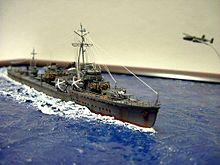 1/700 scale Japanese destroyer Harusame plastic model kit released by Tamiya
1/700 scale Japanese destroyer Harusame plastic model kit released by Tamiya
But the continental Europeans have an on-going project of getting rid of all conversions and measurements which they consider non-standard. As they saw how four Japanese model-making firms (Tamiya, Hasegawa, Aoshima, and Fujimi) formed a cartel to apportion out the project of putting out waterline kits of the whole fleet of Japanese warships of the Second World War on the market in a proportion that no firm from any other country did - 1:700, the Europeans are attempting to have the scale of 1:400 standardized for full-hull model ships, even though some Japanese firms have produced larger ships in the luxury scale of 1:350. On the other hand, the rise of the resin kit industry in the 1990s led to the introduction of companies around the world producing kits in the 1:350 and 1:700 scales to match pre-existing injection molded kits, creating in limited production a large variety of kits of subjects which traditional injection-molding makers have not invested resources to produce, due to the expense of creating a large injection mold. In scales more conducive to wargaming, continental Europeans have long marketed waterline kits in the scales 1:1250 and more recently 1:2500 to supplement the British and American lines. The Chinese are joining them. Such trends toward standardization has not affected the Japanese firm Nichimo, which still produces fit-in-the-box sizes from old molds, and 1:450 size models.
Manned ship models
Main article: Port RevelMany research workers, hydraulics specialists and engineers have used scale models for over a century, in particular in towing tanks. Manned models are small scale models that can carry and be handled by at least one person on an open expanse of water. They must behave just like real ships, giving the shiphandler the same sensations. Physical conditions such as wind, currents, waves, water depths, channels and berths must be reproduced realistically.
Manned models are used for research (e.g. ship behaviour), engineering (e.g. port layout) and for training in shiphandling (e.g. maritime pilots, masters and officers). They are usually at 1:25 scale.
Model tanks and wargaming
Main articles: Model military vehicle and Miniature wargamingJust before the 20th century, the British historian (and science fiction author and forgotten mainstream novelist) H. G. Wells published a book, Little Wars, on how to play at battles in miniature. His books use 54 mm lead figures, particularly those manufactured by Britains. His fighting system employed spring-loaded model guns which shot matchsticks.
This use of physical mechanisms was echoed in the later games of Fred Jane, whose rules required throwing darts at ship silhouettes; his collection of data on the world's fleets was later published and became renowned. Dice have largely replaced this toy mayhem for consumers.
For over a century, toy soldiers were made of white metal, a lead-based alloy, often in architect's scale-based ratios in the English-speaking countries, and called tin soldiers. After the Second World War, such toys were on the market for children but now made of a safe plastic softer than styrene. American children called these "army men". Many sets were made in the new scale of 1:40. A few styrene model kits of land equipment were offered in this and in 1:48 and 1:32 scales. However, these were swept away by the number of kits in the scale of 1:35.
Those who continued to develop miniature wargaming preferred smaller scale models, the soldiers still made of soft plastic. Airfix particularly wanted people to buy 1:76 scale soldiers and tanks to go with "00" gauge train equipment. Roco offered 1:87 scale styrene military vehicles to go with "H0" gauge model houses. However, although there is no 1:72 scale model railroad, more toy soldiers are now offered in this scale because it is the same as the popular aircraft scale. The number of fighting vehicles in this scale is also increasing, although the number of auxiliary vehicles available is far fewer than in 1:87 scale.
A more recent development, especially in wargaming of land battles is 15 mm white metal miniatures, often referred to as 1:100. The use of 15 mm scale metals has grown quickly since the early 1990s as they allow a more affordable option over 28 mm if large battles are to be refought, or a large number of vehicles represented. The rapid rise in the detail and quality of castings at 15 mm scale has also helped to fuel their uptake by the wargaming community.
Armies use smaller scales still. The US Army specifies models of the scale 1:285 for its sand table wargaming. There are metal ground vehicles and helicopters in this scale, which is a near "one-quarter-inch-to-six-feet" scale. The continental powers of NATO have developed the similar scale of 1:300, even though metric standardizers really don't like any divisors other than factors of 10, 5, and 2, so maps are not commonly offered in Europe in scales with a "3" in the denominator.
Consumer wargaming has since expanded into fantasy realms, employing scales large enough to be painted in imaginative detail - so called "heroic" 28 mm figures, (roughly 1:64, or S scale). Firms which produce these do so in so small production lots that they are necessarily made of white metal.
Engine models
Kits for building an engine model are available, especially for kids. The most popular are the internal combustion, steam, jet, and stirling model engine. Usually they move using an electric motor or a hand crank, and many of them have a transparent case to show the internal process in action.
Miniatures in contemporary art
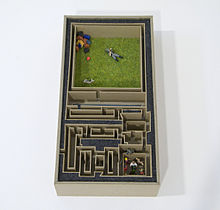 Daniel Dorall, Asylum, 2005, cardboard, sand, hydrocryl, plastic, 20 x 10 x 4 cm
Daniel Dorall, Asylum, 2005, cardboard, sand, hydrocryl, plastic, 20 x 10 x 4 cm
Miniatures and model kits are used in contemporary art whereby artists use both scratch built miniaturizations or commercially manufactured model kits to construct a dialogue between object and viewer. The role of the artist in this type of miniature is not necessarily to re-create an historical event or achieve naturalist realism, but rather to use scale as a mode of articulation in generating conceptual or theoretical exploration. Political, conceptual, and architectural examples are provided by noted artists such as Jake and Dinos Chapman (otherwise known as the Chapman Brothers), Ricky Swallow, Shaun Wilson or the Psikhelekedana artists from Mozambique, James Casebere, Oliver Boberg, and Daniel Dorall.
Scales
- For a more complete list of scale model sizes, see List of scale model sizes and Rail transport modelling scales
Rail transport modellings have unique scale/gauge designations, such as: Z; N; H0; 00; EM; P4; 0; S; 1. Model figure scales are usually expressed as the height of a six-foot (1.83 m) figure; for example: 54 mm. Other model scales are generally given as a ratio which expresses what a measurement on the model represents on the actual object. When buying a model train, scale sizes are referred to by letter name, not number ratio.
For hydraulic models, specific scale rules are applied in order to obtain the correct reproduction of physical phenomenae.
Before the plastic model kit industry
Hobbyists' scale models derive from those used by the firms which made the full-sized products. Originally, a "scale" was a physical measuring instrument, a notion which survives as concerns weight. First among scales are the rulers that are triangular in cross-section and called architect's scales or engineer's scales. The terminology used was of this manner: "scale size to full size", or the reverse. An architect's scale was used to make the first affordable models: doll houses and their furniture. Its popular scales for these miniatures were "one inch to the foot" and "one-half inch to the foot"; there is also "three-quarters inch to the foot".
The proportion of the model to the prototype was originally called "size", as in "full-sized" or "half-sized", as used on a blueprint for making something that would fit on a workbench.
Shipyards were the first to use the scales to make models of things larger than a house. The scales they used were expressed in a different manner: "one-foot-to-the-inch" through "six-feet-to-the-inch" were common. During the Second World War, battleship models were made "eight-foot-to-the-inch", in the later phrasing, "one-eighth-inch to the foot"; you will find these models, used for training workers, in maritime museums. The model ship would be referred to as "one-ninety-sixth size", or "1/96th", but rarely, as there were few scales commonly used; it couldn't possibly be "1/98th scale", for example.
There were also rotary instruments in which one would line up marks on two dials to be able to translate measurements from units on the prototype to units on the model. After the production of kits to make plastic models became an industry, there were developed rulers marked in the model units and which are called scales.
Comparing scales
Phrases used are those of "larger" and "smaller" scales. The scale of 1/8"-to-the-foot is a larger scale than 1/16"-to-the-foot, even though the denominator is smaller. So a larger model is made to a larger scale. You can remember this in that a full-size, or full-scale, model is larger than a half-size model.
Origins of the plastic model kit
For aircraft recognition in the Second World War, the RAF selected models to the scale of "one-sixth inch to the foot" (which was two British lines, a legal division of length which didn't make it to America, besides being a standard shipyard scale). Although some consumer models were sold pre-war in Britain to this scale, the airmens' models were pressed out of ground-up old rubber tires. This is of course the still-popular 1:72 scale. It wasn't predestined to succeed; there were competitors.
The US Navy, in contrast, had metal models made to the proportion 1:432, which is "nine-feet-to-the-quarter-inch". At this scale, a model six feet is about half a statute mile; and seven feet about half a nautical mile.
After the war, firms that moulded models from polystyrene entered the consumer marketplace, the American firm Revell notably offering a model of the Royal Coach around the time of the 1953 coronation. In the early years, firms offered models of aircraft and ships in "fit-the-box" size. A box that would make an impressive gift was specified, and a mould was crafted to make a model that wouldn't ludicrously slide around inside. Modellers could not compare models, nor switch parts from one kit to another. It was the British firm Airfix, whose first self assembly model was a Ferguson tractor around 1950, that brought the idea of the constant scale to the marketplace, and they picked the RAF's scale.
In the 1960s, the company Monogram offered an aircraft actually labeled as ¼" scale, which may have been a common contraction in factories. They meant "one-quarter-inch to the foot", or "one-forty-eighth size". Shortly thereafter, hobbyists lost the ability to distinguish the two, and now the proportion is referred to as scale.
Terminology
The terms and the means of writing them down have changed, and for model kits they are now standardized for the European Union. In English-speaking countries, such terms as "1/72" were used, but the format with a colon as "1:72" is often preferred. The slash format is usually avoided with decimal fractions: "1/76.2" is usually not used; it's "1:76.2" instead. That hybrid 00 gauge can also be expressed by explicitly using a mixed system of units as "4 mm:1 ft" or "1 mm:3 in", but the dimensionless form makes comparison with other scales easier.
Rational choice of scales
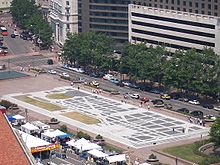 Freedom Plaza is a scale model depicting the layout of the Federal Triangle and part of the National Mall, Washington, DC; the diagonal slash across the layout depicts Pennsylvania Avenue
Freedom Plaza is a scale model depicting the layout of the Federal Triangle and part of the National Mall, Washington, DC; the diagonal slash across the layout depicts Pennsylvania Avenue
The nominal height of a man is simple in the inch-based system: six feet. Many traditional scales are derived so that a figure of such a height against the model can be readily imagined as a simple relation to an inch. Although the metric system has specified a limited series of scales for blueprints and maps, when it comes to models, there may be a problem with these scales for a readily imagined person of 180 centimetres. Model railways have the additional difficulty of having to present the rail gauge as a simple number, the height of a person being secondary. Trade authorities in metric countries are attempting to specify scales that are simple mulitiples of 2 and 5, but neither tracks nor people seem to fit. In such cases, rationalization may actually be invoked for competitive advantage, to prevent interoperability with products from another manufacturing country.
On the other hand, wargaming scales have traditionally been traced to metric system, where the number of millimetres relate to the relative height of the human figure based on 180 cm standard man. Therefore 25 mm scale (popular in historical and fantasy wargaming) refers to 1:72 scale, whilst the 15 mm scale (nowadays the most popular scale in ancient, medieval and Renaissance wargaming) refers to 1:120 scale (Many manufacturers refer to 15 mm as 1:100 scale). Likewise, 50 mm scale is the same as 1:35 military model scale, and 5 mm equals 1:350 naval scale.
Rationalisation typically falls into 2 categories: Industrial Trade, and Hobbies. Industrial trade covers areas like building and maritime architecture where universally accepted scales have been established and are conformed to both in the construction of models and drawings, in order to facilitate smoother co-operation between commercial parties. The rationalisation of hobby scales has been more gradual and organic; largely driven by clubs lobbying industry, as well as tradition, and indirectly, consumer demand. A couple of artificial efforts to standardise have not been successful: i.e. Tamiya in the 1970s with aircraft models in 1/100 scale, and Heller with airline models in 1/125 scale. Even though rationalisation in hobby scales sounds appealing, it has not proved to be historically evident, although there may be some very gradual progress as consumer demand becomes more organised.[citation needed]
Cultural references
- In the movie Zoolander the character Mugatu entices Derek Zoolander to model for his fashion label by offering to build an educational facility and shrine to Zoolander's dead friends called "Derek Zoolander's Centre for Kid's Who Can't Read Good and Other Things". Mugatu shows Zoolander a scale model of the centre and Zoolander freaks out because he thinks it is at 1:1 scale, and thus, very small. He demands that the building must be at least "3 times the size".
- In the movie This Is Spinal Tap, the band request a stage design of the Neolithic site Stonehenge to accompany their song of the same name. Instead of the full size, tiny models are built as it turns out the units on the construction drawing were marked as inches (") instead of feet (').
- Season 7 of TV series CSI: Crime Scene Investigation dealt with the pursuit of The Miniature Killer, a serial killer who would leave a half-inch scale model of the crime scene at each of her murders.
See also
- Computer-aided design
- Die-cast toy
- Historical Miniatures Gaming Society
- IPMS, International Plastic Modellers' Society
- Maquette
- Miniature effect
- Miniature faking
- Miniature figure (disambiguation)
- Miniature park
- Miniature pioneering
- Plastic model
- Rail transport modelling scale standards
- Solar system model
- Standard gauge in model railways
- Unimat
References
- ^ In the Lego community, micro scale can refer to anything smaller than minifig scale (1:48), but 1:192 is occasionally set as a standard micro scale. This ratio is arrived at by scaling a person (6 ft) to the height of a Lego brick (3/8 inches). See Bedford, Alan (2005). The Unofficial Lego Builder's Guide. No Starch Press.
- ^ Morciano, Michele (2003). Classic Waterline Ship Models in the 1:1200/1250 scale. Rome: self published. p. 5.
External links
Categories:- Scale modeling
- Scale model scales
- Architectural communication
- Model aircraft
Wikimedia Foundation. 2010.








